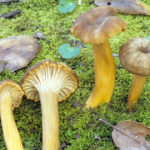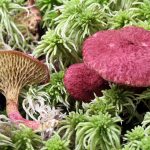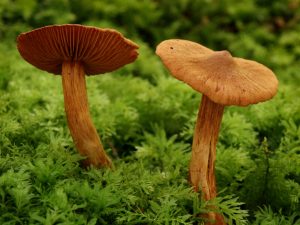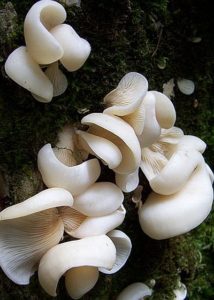Newfoundland and Labrador[i] has only been a Canadian province for not quite a hundred years—and up until a few decades ago it was known simply as Newfoundland. The new name is a bit of a mouthful, so it’s commonly called NL. Even as part of scientific names the abbreviation holds, as a species discovered in the province might receive the species epithet “enelensis.” Say that aloud if you don’t quite get it.
The climate of NL is certainly challenging—part of it is occupied by arctic tundra—but it does have its share of mushroom species[ii], as well as the northernmost reach of the Appalachian Mountains.
The following list is not exhaustive—there are many more edible wild mushrooms in NL than we can include. It’s also not a field guide. If you want to go gather these mushrooms yourself, you will need a quality field guide and, ideally, the help of an experienced forager. It’s not that mushroom identification is all that difficult (alright, sometimes it is—depends on the species), it’s that beginners often miss important details that look obvious to experienced foragers. Basically, until you’re pretty good at identifying many different kinds of mushrooms, don’t forage for the table by yourself.
This list is intended for educational purposes only and should not be considered a substitute for a field guide, spore prints, or an identification app. It’s highly recommended to have an expert guide you in person. If you do decide to go mushroom hunting, it’s essential to bring a quality knife and a basket or bag to collect your findings.
Our Recommended Field Guides for Newfoundland and Labrador
COVER | TITLE | Header | ||
|---|---|---|---|---|
OUR #1 RATED | ||||
Edible Wild Mushrooms
Chanterelles and Friends






The chanterelles are a group if closely-related fungi whose fruiting bodies are all more or less trumpet-shaped and have ridges or veins rather than gills. All are edible. Many are delicious with a distinctive, fruity scent.
Technically, true chanterelles are members of the genus, Cantharellus. But there are several other genera that include species that look like, taste somewhat like, and are sometimes referred to as Chanterelles. Some of these species were once in the Cantharellus genus and are still considered closely related. It seems reasonable to include them in the group. By this definition, then, Newfoundland and Labrador have at least two species, the NL Golden Chanterelle (Cantharellus enelensis) and the Yellowfoot (Craterellus tubaeformis).
Hedgehog Mushrooms, with have short spines rather than gills, are more distantly related to the chanterelles but taste remarkably similar, if not quite as good. NL has two, Hydnum subolympicum and the Depressed Hedgehog (Hydnum umbilicatum).
There are at least two other species that look like and are sometimes called chanterelles, but really aren’t. The Chanterelle Waxycap (Hygrocybe cantharellus) is edible but not choice. The Scaly Chanterelle (Turbinellus floccosus) is not poisonous, but isn’t considered edible, either.
Puffballs




Puffballs are a group of mostly unrelated fungi whose fruiting bodies are all ball-shaped. The spores develop inside the enclosed ball, which eventually ruptures. Many, though not all, are edible when young, before the spores start to mature—though it is important to slice them open vertically before cooking, as that is the only way to be sure it is not an early stage of one of the dangerously toxic Amanitas.
NL has at least two edible puffballs, and they are related to each other: Meadow Puffball (Lycoperdon pratense) and Common Puffball (Lycoperdon perlatum).
Inkcaps






Inkcaps are another group of superficially similar but not closely related fungi. Their claim to fame is that their fruiting bodies partially or completely liquefy at maturity, becoming an ink-like substance. Several are edible before they become ink—and, contrary to popular belief, they are edible afterwards as well. The ink makes an interesting food-dye.
Shaggy Mane (Coprinus comatus) is a popular edible. Common Inkcap (Coprinopsis atramentaria) and Mica Cap (Coprinellus micaceus) are both often listed as toxic, but that, too, is a misconception. They do contain a substance that produces temporary alcohol intolerance, meaning that if you eat either and then drink alcohol any time in the next week or so, you will get mildly ill. But the mushroom itself won’t hurt you.
Boletes








The boletes are related to each other but are no longer all classified in the same genus. In fact, the taxonomy of the whole group is in such a state of flux as of this writing that some boletes get a new scientific name every few years. All boletes have the classic umbrella-like mushroomy shape but with a layer of pores rather than gills. Many (not all!) are edible, and some are choice.
Many of NL’s species are in the Suillus genus. While these are not choice edibles, some people do like them. They look very much like each other, but not much like anything else: Red Bog Bolete (Suillus paluster); Larch Bolete (Suillus clintonianus); Hollow-Stalked Larch Bolete (Suillus ampliporus); and the Purple-Veiled Slippery Jack (Suillus luteus).
Morels (Morchella sp.)


Morels are a group of closely-related edible mushrooms. Though generally considered choice, they are mildly toxic when raw, and even when properly cooked sometimes cause illness. They remain popular, though.
Although morels are distinctive as a group, figuring out which morel you’ve got is a lot harder. It’s to the point that some species were long mistaken for more than one species, while others are species complexes once considered a single species. It’s difficult to be sure exactly which morels NL has, but at least two rare ones have been identified here through genetic analysis, so NL definitely has them[iii].
Rock Tripe (Umbilicaria sp.)


Rock Tripes are lichen. While lichens aren’t mushrooms, they are fungi—fungi that need algae or cyanobacteria or both inside them in order to live. These little guests provide food by photosynthesis, so lichenized fungi don’t grow within a nutritive substrate but instead produce almost plant-like structures so they can expose their algae to the sun.
Rock Tripes somewhat resemble leather or paper discs. They grow on rock, usually in groups. Each one is attached to is rock by a root-like structure at the center of its underside. There are many species, and most, perhaps all, are edible if properly prepared (they aren’t poisonous otherwise, just totally indigestible). While their flavor is typically bland, they do add an interesting—and not leathery or papery—texture to a dish. Yes, we speak from experience.
Please note that Toad-Skin Rock Tripe is a close look-alike, and its edibility is unknown.
Fairy Ring Marasmius (Marasmius oreades)


Fairy Ring Marasmius is a popular edible with a problematic name. It fruits from the ground in groups that often form a ring-shape, the “fairy ring,” and calling it the fairy ring mushroom, as many people do, implies that this growth habit is a good, distinctive field mark. It isn’t. Actually, many mushroom species, including some poisonous ones, sometimes fruit in rings. Careful identification is still a must.
The ring is formed when the mycelium, growing underground, expands outward but dies back in the middle. The ring is invisible (except for turning the grass above it a brighter green) until it fruits, and then a circle of mushrooms appears literally overnight. But any organism that spreads outwards while dying in the middle forms a ring, and besides the multiple species of ring-forming mushrooms, there are also ring-forming lichen and ring-forming plants.
American Matsutake (Tricholoma magnivelare)


There are many Tricholoma species growing across multiple continents. All are edible, and most are good enough to be referred to as Matsutake[iv], a name originally applied to a prized Japanese species. Some taste bland or even bitter and earn the name “false matsutake.” In general, the true matsutakes grow under conifer trees, never hardwoods, and have an enticing, hard-to-describe aroma. At least two can be referred to as American matsutake, but this one is LN’s species.
Apricot Jelly (Guepinia helvelloides)


Apricot Jelly Fungus[v], also sometimes called salmon salad fungus, is trumpet-shaped with a lovely apricot color and a rubbery, almost gelatinous texture. It seems like it ought to be delicious, but unfortunately it is rather bland. You can eat it, though, and it can make a fun accent to other ingredients.
Our Recommended Field Guides for Newfoundland and Labrador
COVER | TITLE | Header | ||
|---|---|---|---|---|
OUR #1 RATED | ||||
Poisonous Mushrooms
The following list is not exhaustive, either—don’t assume a mushroom is edible just because it’s not here.
As you might notice, edibility in mushrooms is a bit of a tricky question. While there are some species that will unambiguously kill you if you eat them (medical treatment can save some poisoning victims, but not all of them), there are others that are safe under some conditions for at least some people some of the time, while sickening others—sometimes seriously. And it’s not always clear what makes the difference. In some cases the risk from eating these sometimes-poisonous mushrooms is clearly very low, while for others the risk is very high. And for many it’s really hard to say. That’s why you’ll see some species listed as edible in some sources that are called poisonous in others. It’s not that the experts are wishy-washy, it’s that they’re trying to take a difficult, complicated subject and make it simple enough to put in a book for non-experts.
When you are an expert, you’ll be able to use your own judgment.
Amanita sp.




The Amanitas are a fascinating genus of mostly beautiful mushrooms, some of which will probably kill you if you eat one. Others are good to eat, and still others sit somewhere in the middle.
The most important group to know about are the Destroying Angels (Amanita Bisporigera, Amanita Virosa, Amanita Verna) white or whitish mushrooms that are indeed often deadly, and are not-infrequently mistaken for almost any white edible out there, including the puffballs, which is resembles in its early “egg” stage. These mistakes are puzzling, as destroying angels seem, at first glance, quite distinctive—and yet people do make the mistakes, a fact worth remembering. You’re never too smart to be dumb, as they say. We haven’t been able to track down which destroying angel NL has (they are not-infrequently mislabeled with the European species’ name in published lists), but at least one of them is here.


Amanita Muscaria is much less dangerous, and can be used as a psychoactive if properly processed first. In some of our articles, we put it under the “magic” heading, although it is chemically very different from the Psilocybin Mushrooms and provides a very different experience. However, a significant number of people get very sick by trying to use fly agaric recreationally after not quite processing it properly, so increasingly we are including it among the poisons. It probably won’t kill you, but you could end up in the hospital for a few days.
Webcaps (Cortinarius sp.)


The Webcaps are a large group of often lovely-looking mushrooms, known for the cobwebby partial veil that tears away from the gills at maturity. A few are known to be dangerously poisonous. The vast majority are of unknown status, and most experts recommend avoiding all of them as a precaution. NL has a huge number of webcap species. It’s best not to eat any of them.
Brown Roll-Rim (Paxillus involutus)


You might be able to eat brown roll-rims[vi] without any apparent ill effects, provided they are properly cooked. Some people do. If you like the taste, you could decide to eat than again. You might even make them a regular part of your diet over many years. If you do, though, you’ll probably die of haemolytic anemia, because these mushrooms have a second toxin, one that is not destroyed by cooking, and it is cumulative, suddenly causing serious illness after years of not causing symptoms at all. You have been warned.
False Morels (Gyromitra sp.)




False morels are a group of morel look-alikes, but the two groups aren’t hard to tell apart, if you know how. The funny things is, most people who eat false morels know exactly what they are and eat them on purpose, insisting that they are perfectly safe. The issue is that these mushrooms are only poisonous sometimes, and the same can be said for true morels. Many mushrooms are considered edible but cause illness for some people some of the time—at what point does the risk become so high that it makes sense to consider the mushroom poisonous?
Obviously, we’ve decided to list false morels as poisonous here, but should you decide to disagree, there are some things to keep in mind. First and foremost, the fumes released from cooking these mushrooms are poisonous, so not only must they be cooked to destroy the primary toxin, but they must be cooked in a very well-ventilated area—consider leaving the room while they cook, too. Second there appears to be a second toxin present, one that sometimes causes illness even if the mushrooms were well-cooked—and this second toxin may also be cumulative. You could eat false morels for years without trouble and then suddenly get very sick.
The third thing to keep in mind is that different false morel species have different toxin loads. Gyromitra esculenta may be one of the most toxic, and even some people who happily eat other false morels will not eat it. The other false morel known to reside in NL, Gyromitra montana, has much less toxin and is sometimes listed as edible.
Angel’s Wings (Pleurocybella porrigens)


Angel’s wings is a curious case, as it was eaten without incident for a very long time by many people until one year several sickened and a few died. None have done so since. So, what changed? And has it changed back? Are these mushrooms safe to eat?
The short answer is no one knows. The fatalities occurred in Japan in a year when unusual weather produced much larger-than normal flushes—with the result that many people ate a lot more angel wings than normal, and many people ate them who ordinarily did not. The substance considered likely responsible for the poisoning is unstable, meaning it is not itself toxic but can spontaneously turn into something else that is. Human sensitively might also vary. If true, this means some meals of angel’s wings are fine while others can kill you. And the more meals get eaten, the more likely a fatality becomes[vii].
What that means for the risk associated with any individual meal? No one knows.
Our Recommended Field Guides for Newfoundland and Labrador
COVER | TITLE | Header | ||
|---|---|---|---|---|
OUR #1 RATED | ||||
Magic Mushrooms
The following[viii] may actually be an exhaustive list, though it’s hard to be sure. Magic is a rare gift, among mushrooms. Accepting that gift from a mushroom is illegal in most jurisdictions, and while psilocybin is among the safest mind-altering substances known, its use is not without risk—serious side effects, while rare, are possible. Please don’t use the following information in a way that gets you hurt or in legal trouble.
Gymnopilus sp.


Here we have a confusing genus with muddled taxonomy. We’re not sure which species NL has, and it’s possible no one else knows, either. They are psychoactive, but are apparently not used very often, as there is very little published information on what using them is actually like.
Banded Mottlegill (Panaeolus cinctulus)


The Mottlegills, or pans, as psychonauts often call them, are a varied lot, with some species being extremely potent while others are totally inactive. The banded mottlegill, which grows almost everywhere in North America, is in the middle, less potent than the famous cubes, but still strong enough to get the job done.
Liberty Cap (Psilocybe semilanceata)


Psilocybe is the genus of the famous and widely-cultivated cubes, but the liberty cap is more potent and just as popular, if not so often cultivated. In fact, this was one of the first magic mushrooms to become popular for recreational use.
Our Recommended Field Guides for Newfoundland and Labrador
COVER | TITLE | Header | ||
|---|---|---|---|---|
OUR #1 RATED | ||||
References:
[i] (n.d.). Newfoundland and Labrador. Wikipedia
[ii] (n.d.). Newfoundland and Labrador, CA Province.
[iii] Voitk, A., Beug, M. W., O’Donnell, K., Burzynski, M. (2015). Two New Species of True Morels from Newfoundland and Labrador: Cosmopolitan Morchella eohespera and Parochial M. laurentiana. Mycologia 108(1).
[iv] Bergo, A. (2023). Matsutake or Pine Mushrooms: Identification, Harvesting, and Cooking.
[v] (n.d.). Foraging for the One of a Kind Apricot Jelly Mushroom. ForageSF
[vi] (n.d.). Paxillus involutus (Batsch) Pers.—Brown Rollrim. First Nature
[vii] Beug, M.W. (n.d.). Pleurocybella porrigens Toxin Unmasked? NAMA
[viii] (n.d.). Which Psilocybin Mushrooms Grow Wild in My Area? Shroomery




